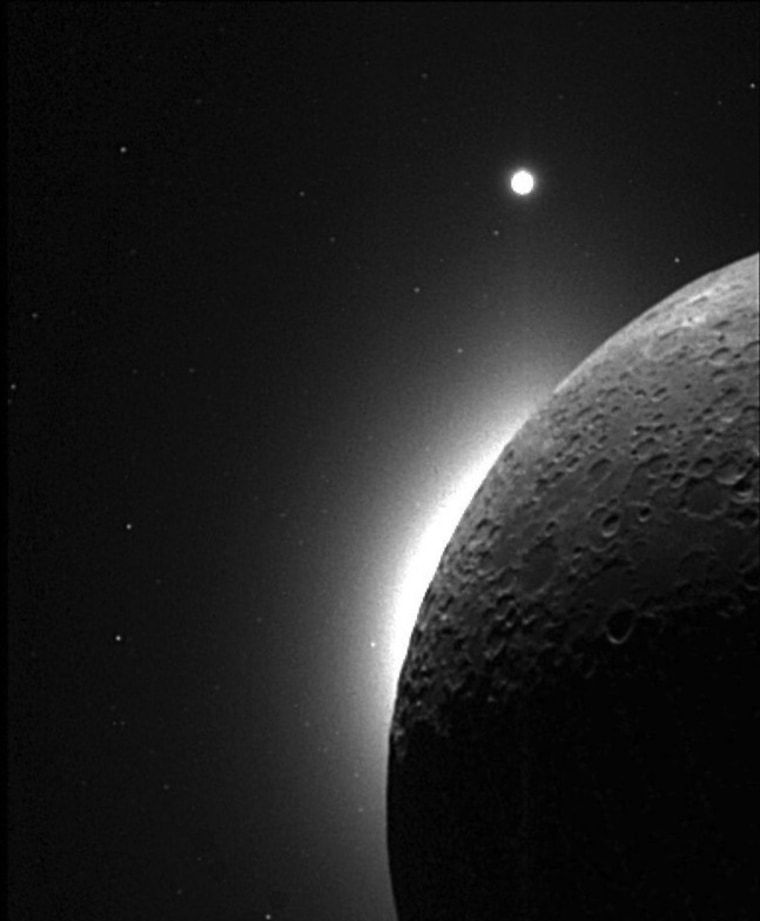When Apollo astronauts first rounded the far side of the moon, they were stunned to find a very bright crescent of light glowing on the horizon at sunset. And, just before sunrise, faint columns of light appeared shortly after the glow.
Now, a new model proposes that fountains of moon dust jet high into the sky and stay there, allowing sunlight to scatter and create glows not usually thought possible in such a tenuous atmosphere. The electrostatic properties of lunar dust have shifted scientists' attention to the moon's boundary of day and night, where a very strong electric field may kick dust high into orbit.
Falling and lifting again in cycles, the lunar dust could create a temporary atmosphere that travels across the moon with the moving boundary between night and day.
Stupefying moon glow
The slim, bright crescent, known as the Lunar Horizon Glow (LHG), stymied attempts to understand it even as it was glimpsed several times during the Apollo 8, 10, and 15 missions, and was recorded by robotic cameras as early as 1966.
On Earth, such displays happen when the sun is blocked by our planet and only its outer light is visible, scattering off of dust and moisture in Earth's atmosphere.
But unlike the Earth, the moon is exposed to space directly without an atmospheric buffer in between. Atoms and molecules so sparse that they rarely collide fill the moon's sky in a layer known as the exosphere. Wind cannot blow, and dust cannot remain suspended very high, because no stack of dense air exists to support the particles.
At 62 miles (100 km) above the surface, the "excessively bright" crescent and its streamers come from an altitude too high for wind-blown dust to achieve anyway, officials with NASA's Goddard Space Flight Center in Greenbelt, Md., said in a statement.
Current lunar models do not predict large amounts of dust could exist in the moon's sky.

Moon dust fountains
The new theory suggests that particularly strong electric fields found at the boundary between day and night are capable of launching charged moon dust particles into orbit through sheer repulsion.
Sunlight hitting the moon's surface causes dust grains to eject electrons, the premise goes. Due to this constant ionization, the entire day-side of the moon would exhibit a positive charge.
At night, the opposite would occur. Exposed to the plasma blowing from the sun, grains of dust receive electrons and become negatively charged.
Electrostatic repulsion among like charges could cause dust particles to levitate 3.3 feet (1 meter) above the surface all over the moon, scientist Denis Richard of NASA's Ames Research Laboratory told Space.com.
The dust stays there like that all night, he said.
But, as the sun sweeps across the lunar plain, surfaces charged one way rapidly would undergo a complete reversal, generating an enormous electric field in the process.
Levitated particles would receive a kick more than a mile into the sky, Richard said. Upon reaching their apex, they drop down in free fall before being smacked up again, in an effect that resembles springing fountains.
"It's something we dont see anywhere on Earth, and it's something that has direct relevance to space exploration, because if you understand how the dust behaves and is charged, you can prepare for moon exploration," Richard said. "Imagine if the dust is charged really, really strongly, you can have some trouble with space equipment [...] it can wear off your equipment because it's abrasive."
A constantly moving zone, the surface area affected by the horizon's strong electric field would span several kilometers, researchers said.
Though no firm evidence exists yet for the presence of electrically charged dust, much less fountains, the theory holds more promise among researchers than its rival, that of stimulated emission by sodium atoms, Richard said.
Closer look needed
In 2012, NASA plans to launch the Lunar Atmosphere and Dust Environment Explorer (LADEE) spacecraft, which will collect samples of lunar dust and particles in the exosphere in order to definitively answer whether a charge exists, and what kinds of molecules are suspended at high altitudes.
"So far, LHG has only been observed near the region where day transitions to night, called the terminator, but it could well be occurring elsewhere," said NASA researcher Timothy Stubbs at the Goddard Space Flight Center in Maryland. "This begs the question: Is LHG (from atmospheric dust) a global phenomenon or is it confined to the terminator region?"
"Were still at the stage of determining whether or not LHG is really there this is one of the major objectives of the LADEE mission," he added.
An earlier version of this report mischaracterized the electric charge of dust grains.
